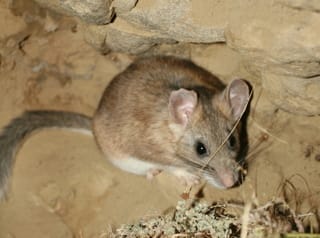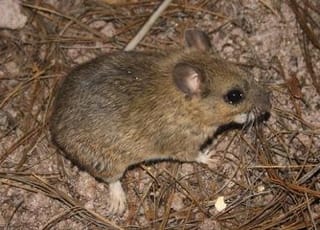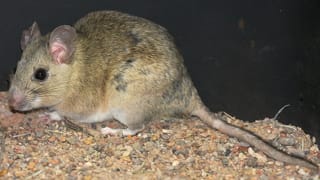This guide initially displays all common mammals. Use the selectors below to view mammals of a particular shape, include rare mammals, or search for them by name.
Mammals are defined as warm-blooded vertebrates with hair or fur and sweat glands — in the females mammary glands, modified sweat glands, produce milk to nourish the young. Most mammals develop a placenta which enables the feeding of the fetus during gestation and give birth to live young. In addition, although most mammals walk on land, many have specific adaptations that allow them to swim, fly, leap between tree branches or even dig extensive tunnels. Many wild mammals are used for both food and fur. while other have been domesticated for their agricultural and scientific importance.
New Mexico ranks high for mammalian diversity in the states in the US and the Pajarito Plateau is home to many of these species. This guide describes all of the larger wildlife found in the area as well as the more common smaller animals with the most abundant being rodents. Local species range from carnivores like the mountain lion and bobcat to ruminants like elk and deer to to several varieties of bats.
Mammal References
Biota Information System of New Mexico
Bogen et al. 1998 Continued Studies of Bat Species of Concern in the Jemez Mountains, New Mexico [PDF]
eNature
Frey et al. 2006 Checklist of New Mexico Mammals [PDF]
New Mexico Tech Mammalian Field Guide
Smithsonian National Museum of Natural History North American Mammals
Threatened, Endangered and Sensitive Species Profile – Los Alamos Laboratory Lands [PDF]
Tyrell and Brack 1992 Survey for Bats in the Los Alamos National Environmental Research Park
Subject Area Experts (all guides)
Steve Cary (butterflies)
Beth Cortright (insects)
Terry Foxx (invasive plants)
Leslie Hansen (mammals)
Richard Hansen (fish, mammals)
Dorothy Hoard (butterflies, trees)
Chick Keller (flowers, herbarium)
Shari Kelley (geology)
Kirt Kempter (geology)
Garth Tietjen (reptiles)
David Yeamans (birds)
Web Development and Content Management
Pat Bacha
Jennifer Macke
Graham Mark
Akkana Peck
Contact
Please contact us for local nature questions and sightings. We welcome comments, corrections, and additions to our guides.
For more information about local nature, please visit our Nature Blog or subscribe to PEEC This Week.
Make Selection
 Photo: latraydean |  Bushy-tailed Woodrat, Packrat(Neotoma cinerea)Family: Cricetidae (New World Rats and Mice, Voles, Hamsters, and Relatives) Size: 11.5 - 18.5 in (29 - 47 cm) Status: native; common Habitat: rocky areas, canyons, coniferous forests, alpine and subalpine habitats These woodrats, also known as packrats, have large ears and long, bushy tails. They are good climbers and use their tails for balance while climbing and jumping. Bushy-tailed Woodrats are solitary and highly territorial. Both males and females use a musky substance to mark their territories. They are active throughout the year and are primarily nocturnal. They prefer green vegetation but will eat twigs, fruits, seeds, mushrooms and even insects. These woodrats gather a variety of sticks, leaves, grass, feathers, stones, etc. to build a large shelter around a tree or rock crevice. This den serves to protect them from predators and acts as an eating platform. Within the den there are various tunnels and chambers used for nesting and food storage. Tracks Info Photos Distribution Featured |
 Photo: Juan Cruzado Cortés |  Mexican Woodrat(Neotoma mexicana)Family: Cricetidae (New World Rats and Mice, Voles, Hamsters, and Relatives) Size: 11.4 - 16.6 in (29 - 42 cm) Status: native; common Habitat: rocky outcrops in montane regions, slopes and cliffs, open pine forests The Mexican Woodrat is grayish-brown with white to buff-colored underparts and a gray throat. It is a solitary animal and can be aggressive toward others of its own species. These woodrats forage on the ground but can climb trees. They prefer foliage but will eat a wide variety of seeds, nuts and berries. They will store large amounts of food. They primarily live in rocky areas and therefore tend not to build large shelters like other woodrats. Rather they take advantage of stony cracks and crevices for nest building. Although these dens are not elaborate, they will still have sticks and other debris as well as fecal pellets around them. Tracks Info Photos Distribution Featured |
 Photo: J. N. Stuart |  White-throated Woodrat(Neotoma albigula)Family: Cricetidae (New World Rats and Mice, Voles, Hamsters, and Relatives) Size: 11.1 - 15.8 in (28 - 40 cm) Status: native; common Habitat: arid areas, brushlands of dry plains and deserts The White-throated Woodrat is one of several species of woodrat that are commonly known as packrats due to their tendency to collect various items including manmade objects. It has a distinctive white throat and underside. In addition, its feet are white. These woodrats eats cholla, yucca, grass and various parts of juniper trees but especially like prickly pear cactus. They will also occasionally eat beetles, ants and some small reptiles. A typical woodrat home is constructed of a variety of sticks and other debris around the base of a tree or shrub. There usually will be several entries and exits with various runways and chambers for food storage and nesting. Despite the fact that a den can be quite large in non-rocky areas, it is occupied by a single woodrat or a mother with young. Tracks Info Photos Distribution Featured |
